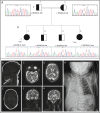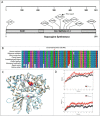Diaphragmatic Eventration in Sisters with Asparagine Synthetase Deficiency: A Novel Homozygous ASNS Mutation and Expanded Phenotype
- PMID: 27469131
- PMCID: PMC5509547
- DOI: 10.1007/8904_2016_3
Diaphragmatic Eventration in Sisters with Asparagine Synthetase Deficiency: A Novel Homozygous ASNS Mutation and Expanded Phenotype
Abstract
Background: Asparagine Synthetase Deficiency (ASNSD; OMIM #615574) is a newly described rare autosomal recessive neurometabolic disorder, characterised by congenital microcephaly, severe psychomotor delay, encephalopathy and progressive cerebral atrophy. To date, seven families and seven missense mutations in the ASNSD disease causing gene, ASNS, have been published.
Methods: We report two further affected infant sisters from a consanguineous Indian family, who in addition to the previously described features had diaphragmatic eventration. Both girls died within the first 6 months of life. Whole exome sequencing (WES) was performed for both sisters to identify the pathogenic mutation. The clinical and biochemical parameters of our patient are compared to previous reports.
Results: WES demonstrated a homozygous novel missense ASNS mutation, c.1019G > A, resulting in substitution of the highly conserved arginine residue by histidine (R340H).
Conclusion: This report expands the phenotypic and mutation spectrum of ASNSD, which should be considered in neonates with congenital microcephaly, seizures and profound neurodevelopmental delay. The presence of diaphragmatic eventration suggests extracranial involvement of the central nervous system in a disorder that was previously thought to exclusively affect the brain. Like all previously reported patients, these cases were diagnosed with WES, highlighting the clinical utility of next generation sequencing in the diagnosis of rare, difficult to recognise disorders.
Keywords: ASNS; ASNSD; Asparagine synthetase deficiency; Cerebral atrophy; Congenital microcephaly; Hyperekplexia.
Figures


Similar articles
-
A novel compound heterozygous missense mutation in ASNS broadens the spectrum of asparagine synthetase deficiency.Mol Genet Genomic Med. 2020 Jun;8(6):e1235. doi: 10.1002/mgg3.1235. Epub 2020 Apr 7. Mol Genet Genomic Med. 2020. PMID: 32255274 Free PMC article. Review.
-
Asparagine synthetase deficiency detected by whole exome sequencing causes congenital microcephaly, epileptic encephalopathy and psychomotor delay.Metab Brain Dis. 2015 Jun;30(3):687-94. doi: 10.1007/s11011-014-9618-0. Epub 2014 Sep 17. Metab Brain Dis. 2015. PMID: 25227173 Free PMC article.
-
Hyperekplexia, microcephaly and simplified gyral pattern caused by novel ASNS mutations, case report.BMC Neurol. 2016 Jul 15;16:105. doi: 10.1186/s12883-016-0633-0. BMC Neurol. 2016. PMID: 27422383 Free PMC article.
-
An intractable epilepsy phenotype of ASNS novel mutation in two patients with asparagine synthetase deficiency.Clin Chim Acta. 2022 Jun 1;531:331-336. doi: 10.1016/j.cca.2022.04.989. Epub 2022 Apr 22. Clin Chim Acta. 2022. PMID: 35469797
-
A novel variant in ASNS gene responsible for syndromic intellectual disability and microcephaly: Case report and literature review.Mol Genet Genomic Med. 2024 Apr;12(4):e2424. doi: 10.1002/mgg3.2424. Mol Genet Genomic Med. 2024. PMID: 38546112 Free PMC article. Review.
Cited by
-
Chemical rescue of mutant proteins in living Saccharomyces cerevisiae cells by naturally occurring small molecules.G3 (Bethesda). 2021 Sep 6;11(9):jkab252. doi: 10.1093/g3journal/jkab252. G3 (Bethesda). 2021. PMID: 34544143 Free PMC article.
-
Characterization of a novel variant in siblings with Asparagine Synthetase Deficiency.Mol Genet Metab. 2018 Mar;123(3):317-325. doi: 10.1016/j.ymgme.2017.12.433. Epub 2017 Dec 20. Mol Genet Metab. 2018. PMID: 29279279 Free PMC article.
-
Amino acid synthesis deficiencies.J Inherit Metab Dis. 2017 Jul;40(4):609-620. doi: 10.1007/s10545-017-0063-1. Epub 2017 Jun 26. J Inherit Metab Dis. 2017. PMID: 28653176 Free PMC article. Review.
-
Nuclear targeted Saccharomyces cerevisiae asparagine synthetases associate with the mitotic spindle regardless of their enzymatic activity.PLoS One. 2020 Dec 21;15(12):e0243742. doi: 10.1371/journal.pone.0243742. eCollection 2020. PLoS One. 2020. PMID: 33347445 Free PMC article.
-
Asparagine Synthetase deficiency-report of a novel mutation and review of literature.Metab Brain Dis. 2017 Dec;32(6):1889-1900. doi: 10.1007/s11011-017-0073-6. Epub 2017 Aug 3. Metab Brain Dis. 2017. PMID: 28776279 Review.
References
LinkOut - more resources
Full Text Sources
Other Literature Sources
Molecular Biology Databases

